In the setting of the current Arab art boom and the political flux ignited by regional uprisings, the difficulty in differentiating between performance art and activism increases, further intertwining the abstract borders that divide them. Nonetheless, while activism pushes its way as a societal form of rejection, performance art conversely sneaks into the social sphere as an accepted method of protest, encouraged by the public as a sign of cultural sophistication.
Within the context of Lebanon, very few artists--no more than ten--use performance art as their medium of choice; being mostly female artists indicates that performance gives women a certain needed outlet, which is otherwise largely absent as a civil force in Lebanese society. Marya Kazoun is one such artist; whose work engages feminist trajectories from the vantage point of her Lebanese Muslim culture, examining its complexities through a non-conventional approach. While most Middle Eastern female artists are currently struggling with contemporary significations of the hijab, the abuse and the unfair treatment they receive often deemed subsidiary, Kazoun explores these issues from a spiritual and theological angle, as if going to the source of the cultural problems women are facing today. To do this she begins from the “biological feminine” not directly and literally, but conceptually through the notion of the creator mother--what it signifies and the invisible obscurities it imposes. [1] In general, Kazoun’s performances tend to capture a metaphoric female existence in light of the cultural issues surrounding this corporal existence.
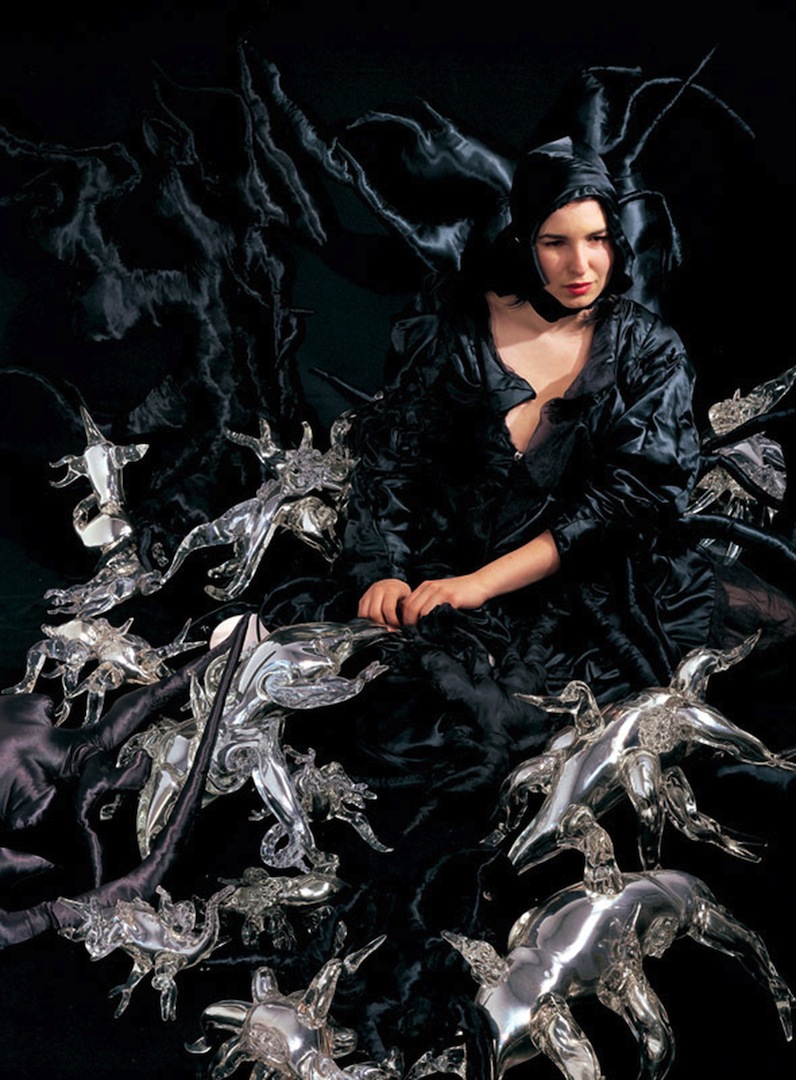 [Marya Kazoun, "Self Portrait" (2004). Image copyright the artist.]
[Marya Kazoun, "Self Portrait" (2004). Image copyright the artist.]
The performance act itself in Kazoun’s art is usually dissolved within fragile, superstitious, and imagined realms that she creates through glass and fabric installations. Pieces of glass are scattered dramatically into a scene of destruction encompassed by organic shapes made from sparkling beads, glossy fabrics, plastic bags, glass and other mixed media. These small sculptures are often created devoid of vibrant color, generally black or white, increasing the subtle gleams emitted by the different textures they are made of. In "Self-Portrait" and "Time After Self-Portrait I and II" (2003-2012), Kazoun’s work shifts from performing on her own to including more participants.
In 2003 and 2004, her "Self-Portrait" performances presented the artist alone in the middle of installation spaces as she created sculptures onsite and was surrounded by a dreamy setting. During the performance, she appears as part of her fashioned landscape as if one of its creatures--the largest in size. In 2003, "Self Portrait" took place in the interior of a bedroom with stitched creatures spread on its furniture. These installations thus become interiors bounded by the exhibition space. The artist executes her performances within these constructed incubators, suggesting a metaphorical birth process corresponding to the female womb. In turn, the audience plays the role of spectators/ voyeurs, representing an embodiment of the exhibition space, and ultimately the public perception of the image of the artist since these works are initially self referential. Accordingly, the overall artwork operates on the tensions between spaces and the dynamics of perception; the inner and outer of the installations, echoing the internal and the external of the female.
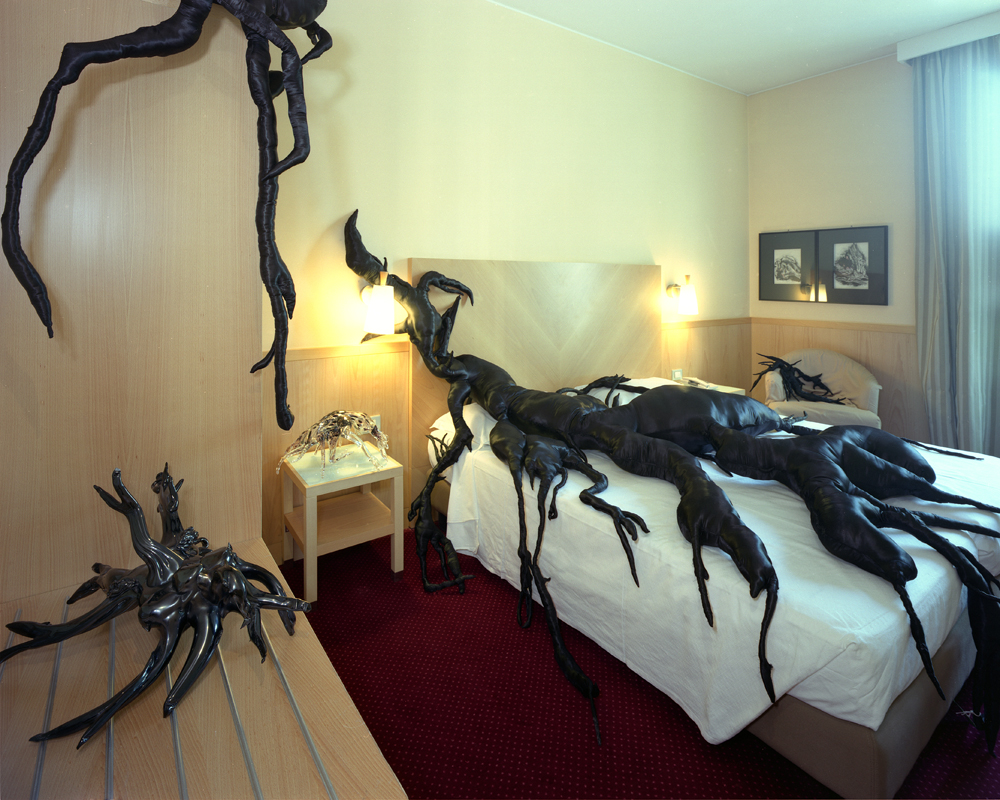 [Marya Kazoun, "Self Portrait," installation and performance at Flash Art Fair (2004). Photo credit Luca Casonato.]
[Marya Kazoun, "Self Portrait," installation and performance at Flash Art Fair (2004). Photo credit Luca Casonato.]
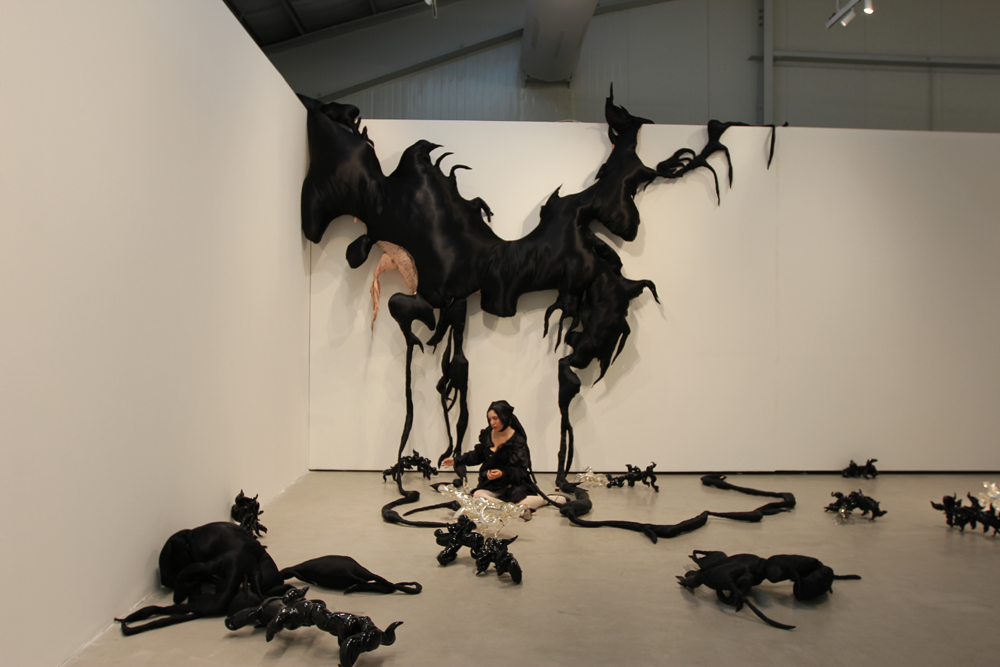 [Marya Kazoun, "Time After Self-Portrait II," performance at Beirut Exhibition Center (2012). Image copyright the artist.]
[Marya Kazoun, "Time After Self-Portrait II," performance at Beirut Exhibition Center (2012). Image copyright the artist.]
The same performance was developed in 2009 with the artist no longer on her own but in collaboration with additional performers. Nonetheless, her role as the creator is reinforced since these creature-performers are covered from head to toe and pumping with life in outfits that she has fastened by hand. Only Kazoun’s face is visible while she sews additional fabric sculptures. Several performers move around before the audience and then transition to the general public, taking the performance from the intimacy of the exhibition space to the social realm of the outside. Kazoun’s 2009 performance relocates the role of the audience from passive spectators to active participants, for her creatures now interact with viewers on the streets, buildings, and gardens of a public space. The ‘outer’ is no longer confined to the inner of the gallery space and its specific visitors but has become the outer-external. This is in contrast to her performances of 2003 and 2004 in which the work played on the tensions between two inners, the inner of the installation space and the inner of the exhibition space. Thus, the 2009 performance moves from the private zone into the public zone and with this the perception of the female as depicted by Kazoun interrupts and confronts the exact socio-political context that she is critiquing.
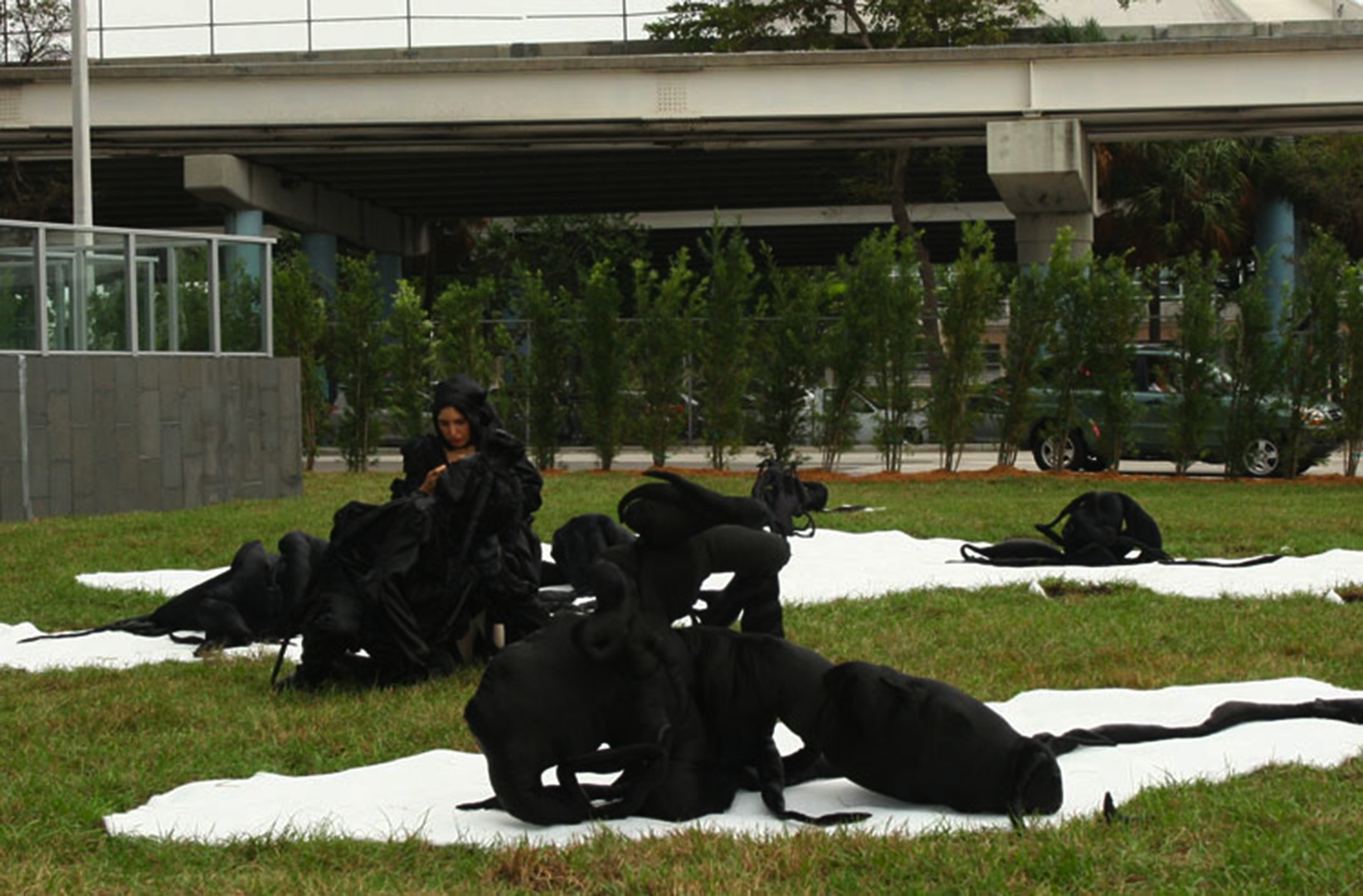 [Marya Kazoun, "Time After Self Portrait" collaborative performance at Marquis Miami (2009). Image copyright the artist.]
[Marya Kazoun, "Time After Self Portrait" collaborative performance at Marquis Miami (2009). Image copyright the artist.]
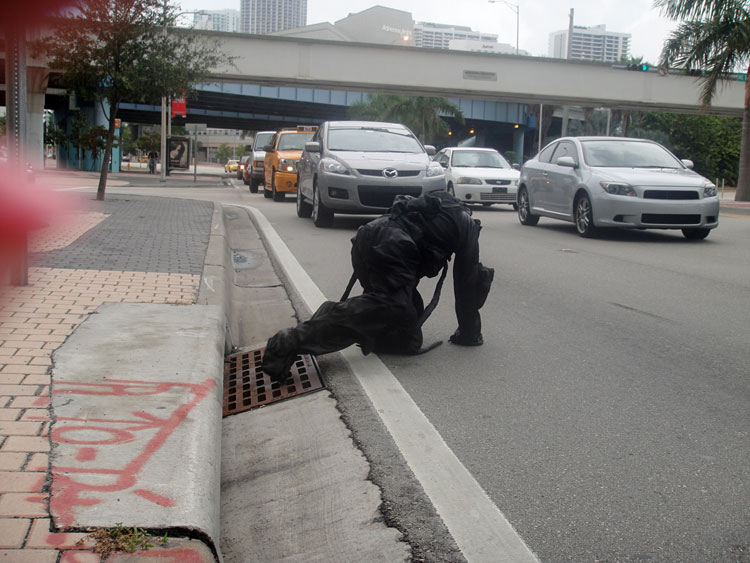 [Marya Kazoun, "Time After Self Portrait" collaborative performance at Marquis Miami (2009). Image copyright the artist.]
[Marya Kazoun, "Time After Self Portrait" collaborative performance at Marquis Miami (2009). Image copyright the artist.]
Kazoun translates elements of the feminine superstitious and its “evil” connotations from the perspective of various contemporary Islamic ideologies through notions of creation and identity formation. The artist acknowledges a social existence that is positioned as an evil, perilous feminine and further exaggerates it through the visual with the multiplying and spreading of her glass-fabric creatures as fragments of her culturally “evil” existence. These installations within the performance, in turn, generate landscapes or “Personal Living Spaces,” as Kazoun describes them, positing the superstitious in a dichotomy with the role of the woman as a creator-mother.
While Lebanese artist Zena el Khalil projected the Middle Eastern feminine as an omen that alludes to wellness and projects the notion of the mother as a source of love and security in her performances “The Pink Bride of Peace” (2003 and 2006), Kazoun presents this concept as it is perceived in the wider milieu of Middle Eastern social institutions with a source of uncertainty and vagueness of boundaries between the visible and the invisible, the public and the private, and the finite physical and the infinite spiritual. Kazoun places the feminine as it is a source of life, and inverts it in death as well.
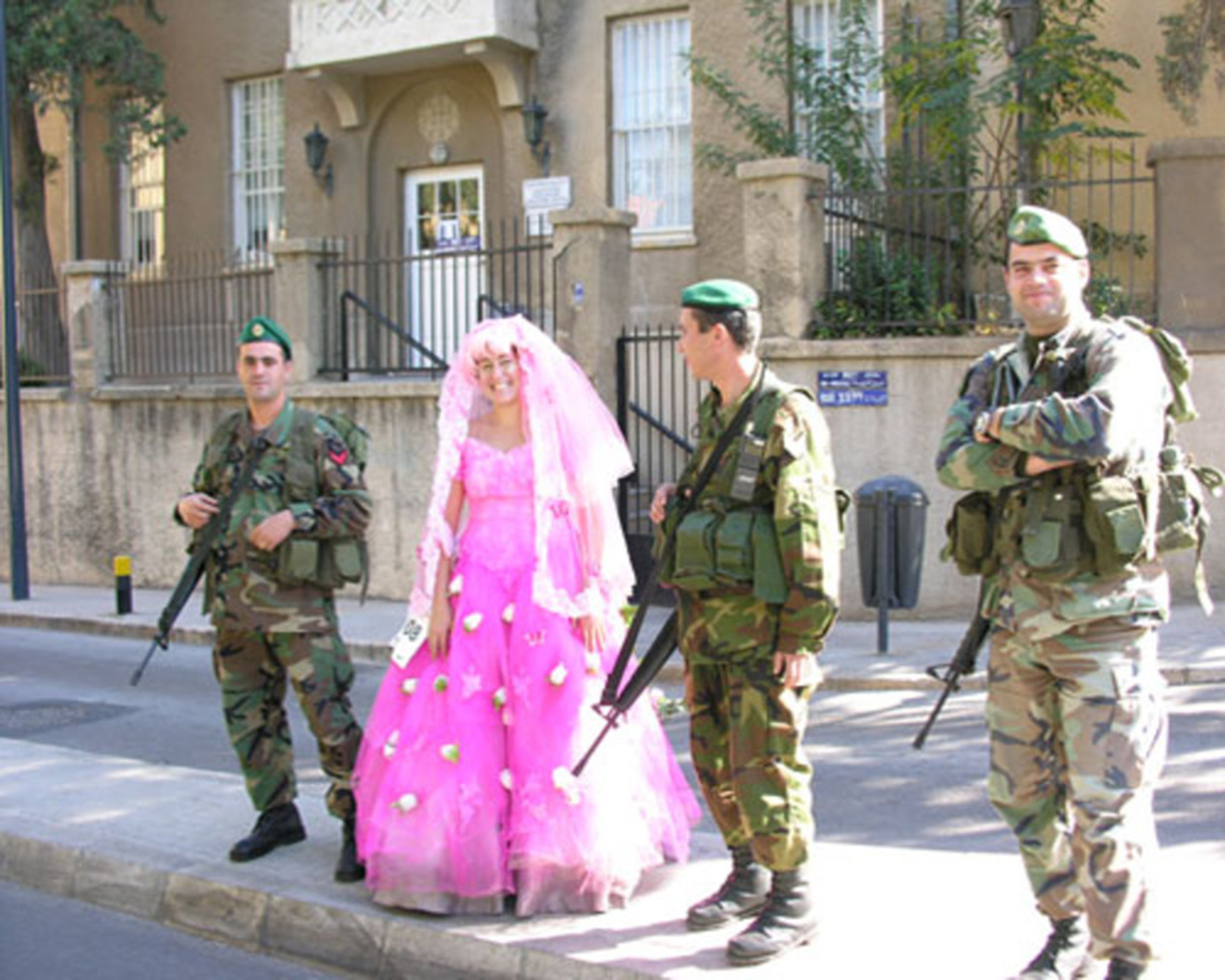 [Zena el Khalil, "The Pink Bride of Peace" (2003 and 2006). Image copyright the artist.]
[Zena el Khalil, "The Pink Bride of Peace" (2003 and 2006). Image copyright the artist.]
In doing so, Kazoun’s work taps into the allegorical concept of what can be termed the “fantastic feminine”; extending from religion and tradition and on the verge between the biological and social image of the female. Kazoun particularly demonstrates the ability of the female body to give life through birth and to symbolize physical mortality through the merging of the non-spaces between life and death, thus presenting life within life and a certain power related to creation and destruction and the corresponding imaginaries of existence. The artist projects the image of an inner being, slipping between a pure creator and a malicious female, simultaneously combining the two as one. Unlike the Lebanese artist Rima Najde’s work “Dress Me How You Like” (2012), where she invited the audience to dress her with outfits from the Western imaginary of Orientalism, Kazoun`s stitching of her performance outfits emphasizes elements from a personal cultural imaginary. Najde’s work corresponds directly to the literal image of the exotic Middle Eastern woman from a Western stereotypical angle; Kazoun alternatively plays along the lines of Arab superstition and Muslim tradition to develop a fantastical visual vocabulary, which, although relatively new to the current Middle Eastern setting, is nonetheless ideologically familiar to its philosophies.
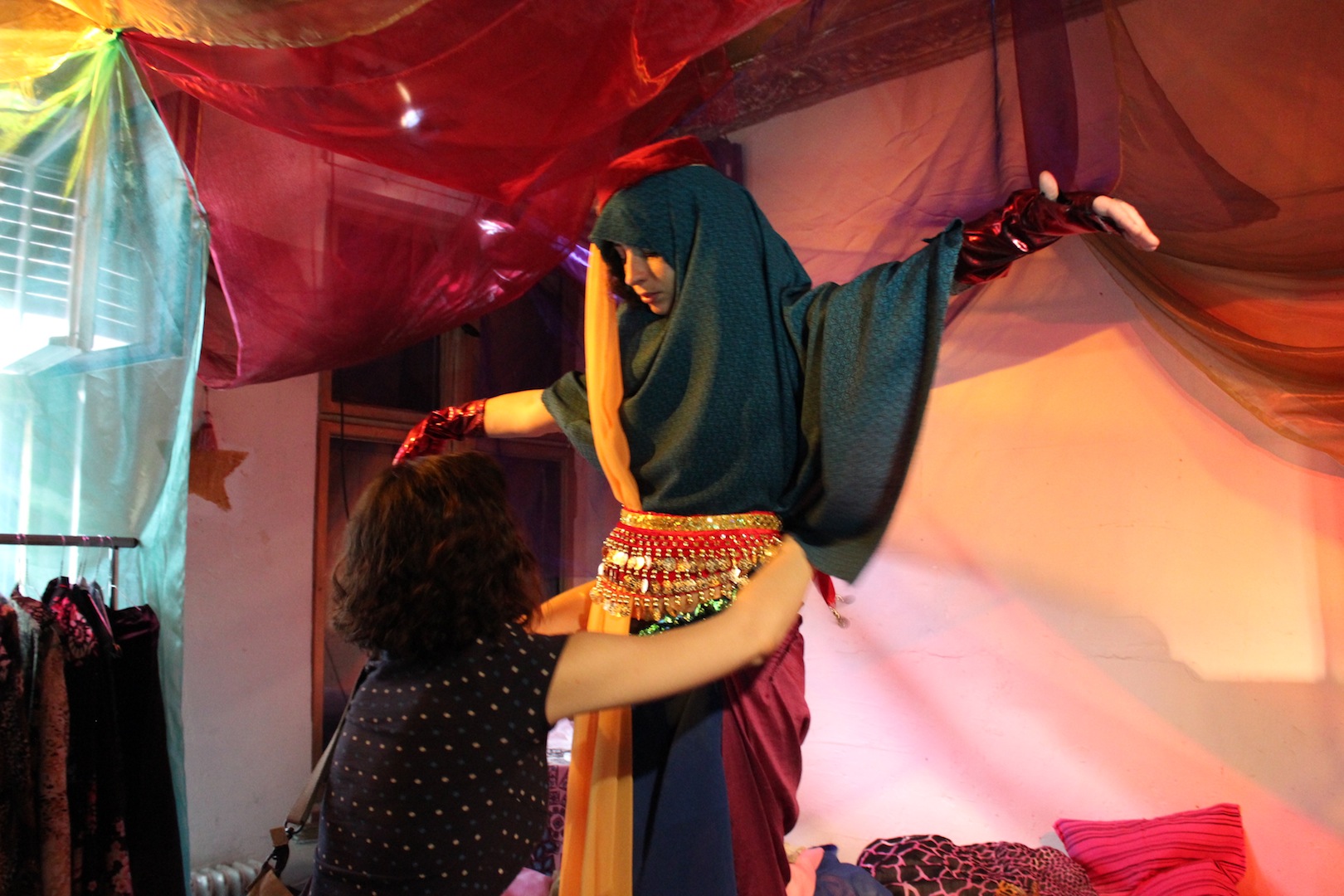 [Rima Nadje, "Dress Me How You Like" (2012). Image copyright the artist.]
[Rima Nadje, "Dress Me How You Like" (2012). Image copyright the artist.]
It can be argued that artists create works of art through a mysterious relationship that exists between them and their medium of choice. The process of giving birth to an artwork, so to speak, is a shadowy formation in which the artwork itself gains life from the artist’s own being. The route for creation is vague and transitory but not isolated from its context. Every artwork then, whether willingly or spontaneously, is a combination of cultural connotations purposing an experimentation of new cultural meanings and ultimately a reordering of a cultural system. Therefore, art is a form of social change, functioning from within the social institutions of the public system. Yet, performance art intersects with society in a more immediate manner than other forms of art in the same vein that activism engages with political and social issues.
With local feminist voices increasingly challenging the social disparities and direct discrimination that Arab women face, specifically as a reaction to the growing number of Islamist groups dominating public discourse, one re-questions the meaning of feminism, religion and activism. Thus it is only logical to compare the “Brides of Peace” from the Medhat Basha market in Damascus, to Khalil’s artwork “The Pink Bride of Peace”, and the actions of the Arab members of FEMEN to Najde’s “Dress Me How You Like” to highlight feminism as an epistemological process in order to provoke the pre-received knowledge surrounding women. Within a Middle Eastern setting that is rich in superstition and make-believe traditions, the performances of Kazoun expand the challenging of ready-made knowledge on women towards a ‘magical,’ mythological realm, provoking its social sphere on a political level while disrupting the aura that exists around this very sphere.
______________
[1] Simone de Beauvoir, Le Deuxieme Sexe, 1949.